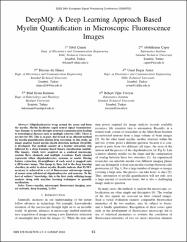DeepMQ: A deep learning approach based myelin quantification in microscopic fluorescence images

Göster/
Erişim
info:eu-repo/semantics/openAccessTarih
2018Yazar
Çimen, SibelÇapar, Abdülkerim
Ekinci, Dursun Ali
Ayten, Umut Engin
Kerman, Bilal Ersen
Töreyin, Behçet Uğur
Üst veri
Tüm öğe kaydını gösterKünye
Çimen, S., Çapar, A., Ekinci, D. A., Ayten, U. E., Kerman, B. E. ve Töreyin, B. U. (2018). DeepMQ: A deep learning approach based myelin quantification in microscopic fluorescence images. European Signal Processing Conference (EUSIPCO) içinde (61-65. ss.). Rome, Italy, 3-7 September, 2018. https://dx.doi.org/10.23919/EUSIPCO.2018.8553438Özet
Oligodendrocytes wrap around the axons and form the myelin. Myelin facilitates rapid neural signal transmission. Any damage to myelin disrupts neuronal communication leading to neurological diseases such as multiple sclerosis (MS). There is no cure for MS. This is, in part, due to lack of an efficient method for myelin quantification during drug screening. In this study, an image analysis based myelin sheath detection method, DeepMQ, is developed. The method consists of a feature extraction step followed by a deep learning based binary classification module. The images, which were acquired on a confocal microscope contain three channels and multiple z-sections. Each channel represents either oligodendroyctes, neurons, or nuclei. During feature extraction, 26-neighbours of each voxel is mapped onto a 2D feature image. This image is, then, fed to the deep learning classifier, in order to detect myelin. Results indicate that 93.38% accuracy is achieved in a set of fluorescence microscope images of mouse stem cell-derived oligodendroyctes and neurons. To the best of authors' knowledge, this is the first study utilizing image analysis along with machine learning techniques to quantify myelination.

















